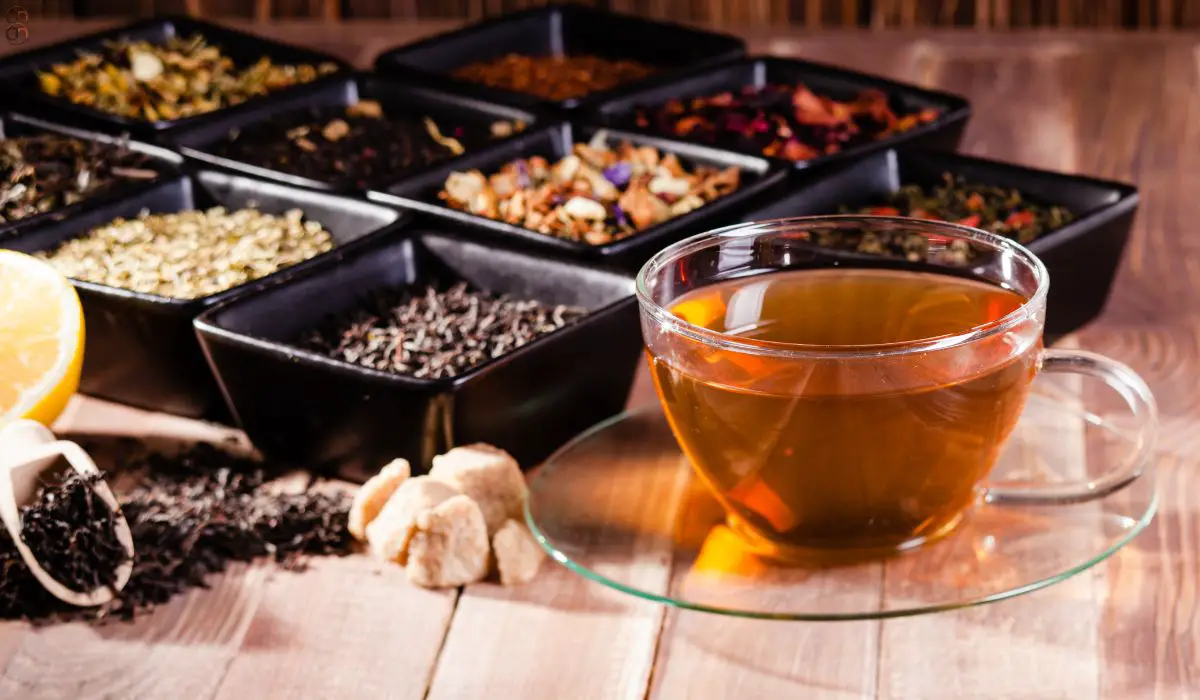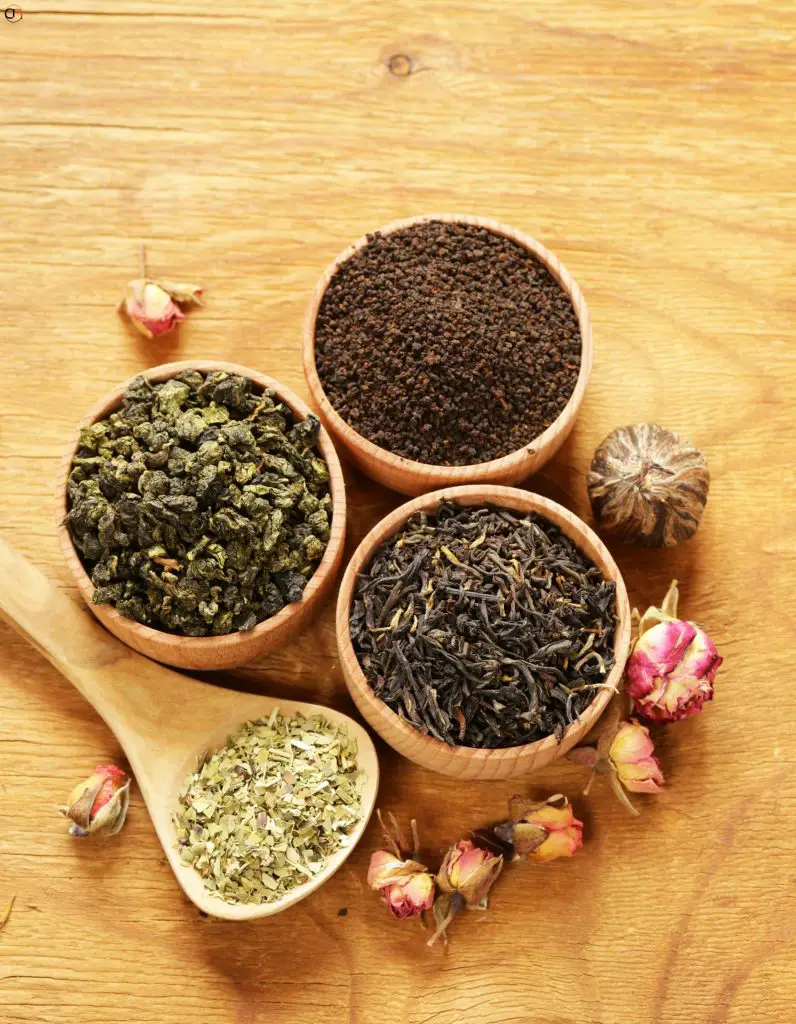Tea is more than just a beverage—it’s an experience filled with rich aromas, soothing warmth, and diverse flavors.
From bold and earthy to floral and fruity, each type of tea offers a unique taste profile that caters to different preferences.
The robust depth of black tea, the delicate sweetness of white tea, and the refreshing zest of herbal blends all bring something special to the cup.
Get types of tea flavours, their characteristics, and how they can elevate your tea-drinking experience. Get ready to explore the fascinating world of tea, one sip at a time!
Types of Tea Flavors:
Tea offers an incredible variety of flavors, each with its unique profile, making every cup an opportunity to discover something new. Here’s a breakdown of the different types of tea flavours and what makes each one special:
1. Black Tea – Bold and Robust
Black tea is known for its strong, full-bodied flavor with a malty, sometimes astringent profile. It’s the most oxidized tea, which gives it its deep color and intense flavor. Common varieties include:
- Assam – Rich and malty with a slight sweetness
- Darjeeling – Light and floral with a muscatel taste
- Earl Grey – Infused with fragrant bergamot citrus, offering a refreshing twist
Black tea can be enjoyed on its own, with milk, or sweetened, and it pairs well with hearty breakfasts or rich desserts.
2. Green Tea – Fresh and Light
Green tea has a refreshing, grassy flavor that varies depending on the region and processing method. It is less oxidized than black tea, which helps preserve its delicate taste and antioxidants. Popular green tea varieties include:
- Sencha – Fresh and slightly grassy, with a smooth finish
- Matcha – Sweet, umami, and rich, often used in Japanese tea ceremonies
- Jasmine Green Tea – Green tea blended with jasmine flowers, offering a sweet floral aroma
Green tea is often enjoyed without additives to appreciate its natural flavor, though a splash of lemon or a hint of honey can enhance the experience.
3. White Tea – Delicate and Sweet
White tea is the least processed of all teas, offering a subtle and naturally sweet flavor. The leaves are gently harvested and dried, preserving their delicate essence. Popular white tea varieties include:
- Silver Needle – Light, sweet, and slightly floral
- Bai Mu Tan – Fresh, mild, with a hint of fruitiness
White tea’s lightness makes it a soothing choice for those who prefer a soft, easy-drinking tea. It’s best enjoyed without milk or sugar to savor its natural flavor.
4. Oolong Tea – Smooth and Complex
Oolong tea is semi-oxidized, falling between black and green tea in flavor complexity. It offers a rich, smooth flavor with floral or fruity notes, depending on the variety. Famous oolong teas include:
- Tie Guan Yin – Floral, sweet, and slightly creamy
- Formosa Oolong – Rich and full-bodied with a honey-like sweetness
Oolong tea is perfect for those who enjoy a balance between bold and delicate flavors and pairs well with light meals or snacks.
5. Herbal Tea – Naturally Caffeine-Free
Herbal teas are not technically “true” teas, as they are made from herbs, flowers, fruits, and spices rather than tea leaves. They come in a wide variety of flavors and are often used for their medicinal or calming properties. Some popular herbal teas include:
- Chamomile – Light, floral, and calming
- Peppermint – Refreshing, cooling, and soothing to the stomach
- Hibiscus – Tart and fruity, with a bright red color
Herbal teas are perfect for relaxing and unwinding, as they are naturally caffeine-free and often have a soothing effect.
Explore different tea types to find your favorites and enjoy the richness of flavors that each tea brings to your cup.
Exploring Unique Tea Flavor Profiles:
Tea offers a diverse range of flavors, from delicate and floral to bold and earthy. Understanding different tea flavor profiles helps in selecting the perfect tea to suit your mood and taste. Here’s a look at some of the most unique and distinct flavor profiles found in tea.
1. Floral Flavors – Delicate and Aromatic
Floral teas have a naturally sweet and fragrant aroma, often derived from flower petals or blossoms. These teas are soothing, elegant, and perfect for relaxation.
- Jasmine Green Tea – Light, sweet, and aromatic with a delicate floral essence.
- Chamomile Tea – Mild, apple-like sweetness with calming effects.
- Lavender Tea – Subtle, herbal, and relaxing with a soft floral aroma.
2. Fruity Flavors – Bright and Refreshing
Fruity teas have a naturally sweet or tangy taste, often blended with dried fruits or citrus peels. They are refreshing and great for both hot and iced tea.
- Hibiscus Tea – Tart and cranberry-like with a vibrant red color.
- Berry Infusions (Raspberry, Blueberry, Strawberry Tea) – Naturally sweet and slightly tangy.
- Citrus Teas (Lemon, Orange, Bergamot in Earl Grey) – Zesty, uplifting, and invigorating.
3 Spicy and Warming Flavors
Spiced teas provide warmth and depth, often featuring a combination of herbs and bold spices. These teas are perfect for cozy evenings or digestive benefits.
- Chai Tea – A rich blend of black tea with cinnamon, ginger, cardamom, and cloves.
- Ginger Tea – Strong, zesty, and soothing, often used for digestion.
- Turmeric Tea – Earthy, slightly bitter, and warming with anti-inflammatory benefits.
4. Earthy and Woody Flavors
These teas have deep, rich flavors, often derived from aged or fermented leaves. They offer a grounding and full-bodied experience.
- Pu-erh Tea – Aged, fermented black tea with a smooth, earthy taste.
- Rooibos Tea – Naturally sweet, nutty, and slightly woody.
- Dandelion Tea – Herbal with mild bitterness and roasted undertones.
5. Sweet and Nutty Flavors
Some teas have a natural sweetness or a nutty richness, making them smooth and comforting.
- Oolong Tea (Milk Oolong, Tie Guan Yin) – Buttery, creamy, and slightly floral.
- Almond or Hazelnut Teas – Nutty and smooth with a toasty aroma.
- Honeybush Tea – Naturally sweet and mild with a honey-like flavor.
Tea flavors are as diverse as the cultures that enjoy them. Experiment with different blends to discover your perfect cup!
How to Enhance Tea Flavors:
Tea is naturally rich in flavor, but small adjustments can bring out its best qualities, making each sip more enjoyable. Whether you prefer a stronger brew, a touch of sweetness, or added complexity, here are some types of tea flavours that easy ways to enhance the taste of your tea.
1. Adjust Brewing Time and Temperature
The right brewing method is essential for unlocking the full flavor of tea. Over-brewing can make it bitter, while under-brewing may result in a weak taste.
- Green Tea – Steep at 175–185°F (80–85°C) for 2–3 minutes to maintain its fresh and light taste.
- Black Tea – Use boiling water (200–212°F or 93–100°C) and steep for 3–5 minutes for a strong, bold flavor.
- Herbal Tea – Steep at 200–212°F (93–100°C) for 5–10 minutes to extract full flavors.
2. Add Natural Sweeteners
A hint of sweetness can balance bitterness and enhance the natural flavors of tea. Instead of refined sugar, try these healthier alternatives:
- Honey – Provides a smooth, floral sweetness, great for herbal and black teas.
- Maple Syrup – Adds a mild caramel-like sweetness.
- Stevia or Monk Fruit – A calorie-free option that enhances sweetness without overpowering the tea.
3. Infuse with Fruits and Citrus
Fresh fruits add natural sweetness and a refreshing twist to tea.
- Lemon or Lime – Brightens green and black teas with a zesty kick.
- Orange Peels – Adds a mild citrusy aroma and flavor.
- Berries (Raspberries, Blueberries, Strawberries) – Introduce fruity depth to herbal or black teas.
4. Enhance with Herbs and Spices
Adding spices and herbs deepens the flavor profile and provides extra health benefits.
- Mint Leaves – Refreshing and cooling, ideal for green and herbal teas.
- Ginger – Adds warmth and a slight spice, perfect for digestion.
- Cinnamon or Cloves – Brings a cozy, slightly sweet, and spiced flavor to chai and black teas.
5. Blend Different Tea Types
Mixing teas can create unique flavors and aromas. Try these combinations:
- Jasmine + Green Tea – Floral and refreshing.
- Black Tea + Rooibos – A rich, bold, and slightly nutty mix.
- Peppermint + Chamomile – A soothing, caffeine-free herbal blend.
6. Use High-Quality Water
Water quality affects tea’s taste. Using filtered or spring water instead of tap water ensures a clean, pure flavor without unwanted chemicals or minerals.
7. Add Dairy or Plant-Based Milk
Milk enhances texture and smooths out strong flavors, especially in black and chai teas.
- Regular Milk or Cream – Creates a rich and creamy texture.
- Almond or Coconut Milk – Adds a subtle nutty or tropical taste.
- Oat Milk – Naturally sweet and creamy, perfect for tea lattes.
Simple adjustments like changing brewing time, adding natural sweeteners, or experimenting with spices can transform your tea into a flavorful experience.
Get More: What To Eat On A Detox Time
Last call:
Tea is more than just a beverage—it’s an experience that can be customized to suit your taste and preferences.
If you love bold black teas, delicate floral blends, or refreshing herbal infusions, there are countless ways to enhance your tea-drinking journey.
By experimenting with brewing techniques, natural sweeteners, herbs, and spices, you can create the perfect cup tailored to your liking.
Now it’s your turn! Start exploring new tea flavors and experimenting with different combinations.
Share your favorite tea blends or tips in the comments, and don’t forget to follow us on Pinterest for more tea recipes, brewing guides, and inspiration.
FAQs:
Q. what is the best types of green tea flavours?
Green tea flavors range from grassy and vegetal (Sencha) to nutty and toasty (Hojicha) and sweet and umami-rich (Matcha). Some varieties, like Jasmine Green Tea, have floral notes.
Q. How can I naturally sweeten my tea?
You can use honey, maple syrup, stevia, or dried fruits like apple or berries to add natural sweetness without overpowering the tea’s flavor.
Q. Which teas have a bold and strong flavor?
Black teas like Assam, English Breakfast, and Pu-erh offer bold, malty, and rich flavors, perfect for those who enjoy a stronger taste.
Q. What herbs can enhance tea flavors?
Herbs like mint, ginger, lavender, cinnamon, and lemongrass can add refreshing, spicy, floral, or citrusy notes to tea blends.
Q. What tea flavors are best for relaxation?
Chamomile, lavender, peppermint, and valerian root teas are great for relaxation, offering soothing and calming properties.



